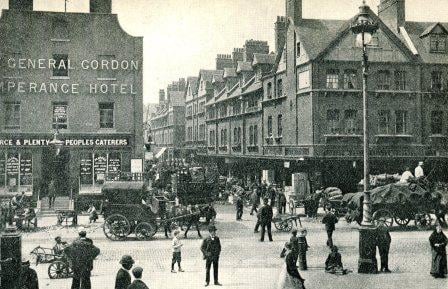With the murder of Annie Chapman on 8th September 1888 the unease that had been bubbling away in the East End of London since the murder of Martha Tabram in early August 1888 now gave way to outright terror and panic.
There was a dawning realisation that one man might well be responsible for the atrocities as opposed to the theory that had been generally held after the previous murders that the crimes were, in fact, gang related.
The Star newspaper told its reader on the afternoon of the 8th September that “a nameless reprobate -half beast, half man – is at large, who is daily gratifying his murderous instincts on the most defenceless classes of the community.”
It went on to inform (or should that be terrify?) its readers with the grim prophecy that “the ghoul-like creature who stalks the streets of London…is simply drunk with blood, and he will have more.”
But, on the 9th September, a witness came forward who, it was though, may have well have seen the man responsible for the murder of Annie Chapman shortly after her murder had taken place.
The story doing the rounds concerned Mrs Fiddymont, who was the landlady of the Prince Albert pub in Brushfield Street, just across the road the the Commercial Street end of Hanbury Street.

Apparently, she had been behind the bar of the pub at around 7am on the morning of the murder (8th September 1888) chatting with a friend of hers Mrs Mary Chappell.
Suddenly a man, of foreign appearance, walked in to the pub. His dishevelled state, together with his “evil-looking eyes” absolutely terrified Mrs Fiddymont, so much so that she begged Mrs Chappell, the only other person in the pub, not to leave her alone with him.
The man ordered a glass of ale and, as Mrs Fiddymont turned her back on him to draw the ale, she looked at him in the mirror. She noticed that his shirt was badly torn, he had a streak of blood beneath his right ear, and there was blood between the fingers of his hand.
The man downed his drink in one gulp and then left the pub, hurrying along the street towards Bishopsgate.
Mary Chappell followed him and alerted a passing builder, Joseph Taylor, to this suspicious character walking briskly along the street.
Taylor followed the man and came up-alongside him, at which point, he later commented, he was particularly struck by the fact that the man’s eyes were “as wild as a hawks.”
He also noticed that the man appeared to be holding his coat tightly closed as though he were concealing something underneath it.
Taylor appears to have been somewhat unnerved by the man’s appearance and so he fell back, allowing the man to walk on, although he continued to watch him as far as Dirt’s Dick’s pub on half moon street at which point the man disappeared into the morning crowds.
The fact that the Prince Albert was so close to Hanbury Street meant that the police took this sighting very serious indeed, and Inspector Abberline himself, the detective in charge of the on-the-ground investigation into the killings actually interviewed Mrs Fiddymont and believed her to be a credible witness.
Abberline would later try to link this bloodstained foreigner with two later suspects, but, for the time being, the police could only appeal for information in the hope that someone would come forward to provide them with a solution to the mystery of who was responsible for these, increasingly violent, murders.
And, as if the hunt for the murderer wasn’t putting them under enough pressure, the newspapers began turning on the police and press criticism of their failure to catch the killer began to intensify.
Indeed The Star advised its readers that “…the people of the East End must become their own police..”
